| |
| |
|
|
|
|
| |
Pike’s Peak, Colorado, November 1806:
Believed to be unclimbable by Lieutenant Zebulon Pike, who was stopped at 10,000 feet in November 1806 due to waist-deep snow, the peak nevertheless bears his name. |
|
 |
|
| |
|
|
Pike's Peak marmot photo by Steve Giordano |
|
| |
|
|
|
|
| |
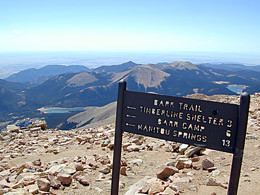 |
|
Pike’s Peak, also referred to as “America’s Mountain”, provides the sweeping view that inspired Katherine Lee Bates, during a wagon trip to the summit, to pen “Oh beautiful, for spacious skies...” It towers slightly east of the Colorado Rockies Front Range and skirts the western edge of the Great Plains. Unlinked to any other mountain, it stands alone and presents an overwhelming presence nearly impossible to describe. At 14,110 feet high, it qualifies as one of Colorado’s many “Fourteeners,” or mountains over 14,000 feet high. |
|
| |
Trail sign on top of Pike's Peak photo by Steve Giordano |
|
|
|
| |
| After a difficult struggle, eventually Mr. Zalmon Simmons made it to the Peak's top on horseback. He was overwhelmed by the view but exhausted by the effort to get there. Thus, he decided to finance a railway so other, less hardy folk, could experience the stunning view with some comfort. (He was, after all, seriously into comfort, as the founder of the Simmons Mattress company.) |
| |
| |
|
|
|
|
| |

|
|
HISTORY:
The steepest and highest cog railway in North America, the Manitou & Pike’s Peak Railway’s (M&PPRW) has been under continuous operation except during the winter months since it was completed in 1891. It is a true leisure railroad and, unlike most tourist trains in Colorado, it was originally built just for sightseeing rather than for the business of carrying ore or other freight. |
|
| |
Manitou & Pike’s Peak Railway logo |
|
|
|
| |
|
|
| |
BUILDING THE RAILROAD:
The grading part of this ambitious civil engineering project started from the top in 1889. Workers commuted to their lofty jobs on burros and blasted gigantic rocks out of the future railroad's path. Once the course was cleared, track was laid from bottom to top. For this task, there was a steam engine to help. After the first 210 feet were laid, the locomotive ferried enough rails and cross ties aloft to build another 210 feet of track, and so on and so on until the rails reached the top. |
|
| |
|
|
|
|
| |
HOW A COG WORKS:
Ordinary rails were out of the question on such a steep grade, so a cog (also called a rack) system was constructed. This consists of two standard gauge rails, which balance the train, and a center rail. This third rail is called a rack, and looks like square teeth with spaces between them. A cog wheel, powered by two Cummins diesel engines, reaches down from the bottom of the rail car with protrusions that fit into the spaces along the center rail. As the cog wheel turns, it slowly propels the rail car up the slope. It can climb as much as 25 feet for every 100 feet it moves forward.
BEGINNING SERVICE:
When on June 30th, 1891, the railway was officially opened, a train loaded with VIPS and reporters set out for the summit – and encountered bad luck. They were stopped by a boulder that had rolled onto the track and had to return to the Manitou Springs Station. By the next day, workmen had cleared the track. This sort of interruption proved to be a rare event.
In the beginning, the teeth on the center rail were lubricated by hand. The worker who did this job was called a “doper”. He carried the grease uphill and brushed the goo onto each tooth of the rack. As he gained altitude, the temperature dropped and the grease would harden. He would have to stop, build a fire, heat up the “dope” then repeat the process going downhill. Employees enjoyed some childlike play by sliding downhill sitting on a shovel balanced carefully on the well-lubricated track.
|
|
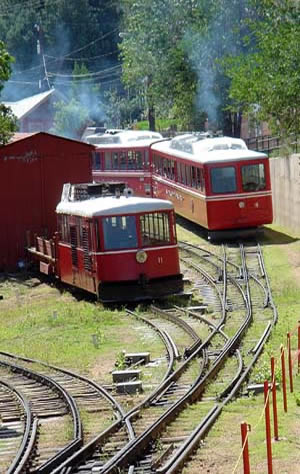 |
|
| |
|
|
Waitin' at the station |
|
| |
|
|
| |
EQUIPMENT:
With an average grade of 16%, the Manitou & Pike’s Peak Railway’s (M&PPRW) first motive power consisted of steam engines with their boilers steeply tilted so they would remain level on the mountain.
In 1938, a lower-maintenance gas rail car was introduced. Soon five streamlined diesel locomotives with matching passenger cars were built by General Electric and steam locomotives began to be phased out. The steamers, because of their heavy weight, were handy for track snow-clearing chores and were used for that purpose until the 1960s.
By 1964 the Swiss Locomotive and Machine Works, having accumulated vast experience with their own county’s numerous cog railways, supplied bright red rail cars which included both passenger seating and an engineer’s stand. This eliminated the need for a separate diesel engine. Eventually the fleet of equipment became large enough to allow for eight departures a day from the station at Manitou Springs. |
|
| |
|
|
| |
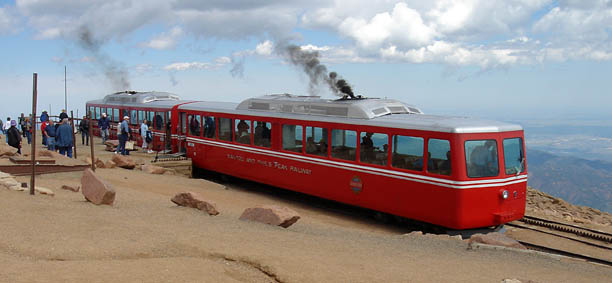 |
|
| |
At the summit |
|
| |
|
|
| |
GETTING TO THE TOP:
Before the Europeans arrived, the Ute Indians climbed Pike's Peak. Now the summit can be climbed - or run to - on a foot trail, driven to on a road, or reached by bicycle or motorcycle. People have foot raced the Peak. Competitions are frequently scheduled for all of the various ways of getting to the top.
But we decide to take the train. |
|
| |
|
|
| |
RIDING THE TRAIN IN THE 21ST CENTURY:
Manitou Springs
The steeply graded road out of town leads to the Alpine-style station. It's a good idea to make reservations or risk joining a large crowd of people who stand nearby, hoping for cancellations on the heavily-booked train.
There can be extreme temperature differences on this trip which can vary between high 80s at the station and icy winds at the 14,110 foot summit. Layers, fleece and windbreakers are advised.
Ratcheting out of the station, we are surrounded by enormous boulders. A modestly-amplified sound system advised us that these are“Pike’s Peak Granite” which is pink, porous and has no commercial value. The tracks climb along a stream, rushing among trees laden with red berries. |
|
| |
|
|
| |
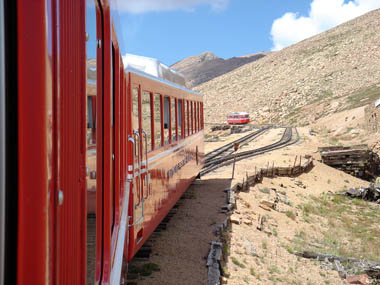 |
|
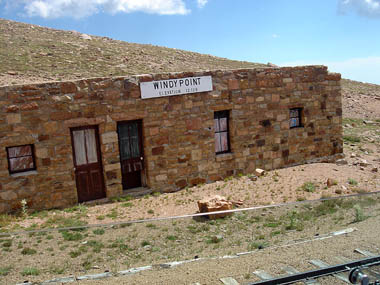 |
|
| |
High above the timber line |
|
Which way is the horizon? |
|
| |
|
|
| |
Our announcer reassures us about the rocks. “We’ve never had a fatality or a serious injury here. Our last major rock fall was in 1975; it happened at night when the trains were not running. We had to blast the boulders off the tracks.
“We’ll now go onto a 25% grade, which the railroad calls “Son of a Gun Hill”. Fur trappers once built cabins up here. And you’ll see a reservoir as we continue to climb. This is in concert with a hydro electric facility, which provides one-and-a-half megawatts to the town of Colorado Springs.
“And there’s the caretaker’s house next to the tracks.” (The caretaker must lead a lonely life on this precipitous slope, but at least he gets to observe up to eight trains a day!)
Ted wondered, “Are all those trees really leaning to the left?” The steep incline, although not uncomfortable, was quite disorienting as there was no sense of where the horizon should be.
“There are usually twelve to fourteen feet of snow each winter on the top,” continues the announcer, “so we send a snowplow out to clear the tracks – the railway now operates all year long, in any weather, but with limited schedules (mostly weekends) mid-November. through April”.
Crawling uphill at an average 10 mph, the train reaches the end of the forest. There is no soil visible; instead there is a rubble of fist-sized sharp rocks.
“There is permafrost year-round here above the tree line,” the announcer continues. “And the wind can blow at over 100 mph”. |
|
| |
|
|
| |
 |
|
| |
The track ends here. Middle rail is the rack or cog. |
|
| |
|
|
| |
BEING AT THE TOP:
At the summit, we have 40 minutes to walk around. We get off and feel as if we are leaning to the right for a few minutes. The rare 360-degree view before us includes four states.
Ted discovers another optical illusion. “Look east. The great plains slope downward out there, but instead they look like they are rising to mountainous heights.”
The flat area on top is perhaps four acres in size. Inside the Cog Wheel Café and sheltered from the weather, we enjoy some hot chocolate—a big favorite here, before the train’s return.
Braking is a more complex operation downhill, slowing the trains to an 8 1/2 mph average.
“We have redundancies going downhill, so don’t worry,” promises the announcer. In other words, there are backup contingencies to avoid hurtling rocket-like and out of control to the bottom.
“We operate with transmission brakes. If they should fail, our backup are the cog brakes. Our third option are the air brakes.
“And if all else fails, there are two big springs at the bottom: Colorado Springs and Manitou Springs!”
We can see both aforementioned towns as well as the plains and the lower reaches of the massive mountain now spread out below with some lakes and reservoirs tucked in amongst the trees on the lower slopes.
The train arrives back at the Manitou Springs depot at 11:10 am. Detraining passengers find that the exit leads right into the gift shop with opportunities to take home a few memorable souvenirs of a tilted trip up Pike's Peak. |
|
| |
|
|
| |
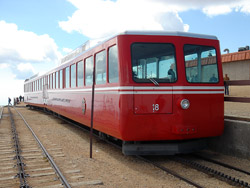 |
|
|
|
| |
This is the railcar we arrived on, resting at summit. |
|
View from the top photo by Steve Giordano |
|
PLANNING YOUR TRIP:
Pikes Peak Cog Railway
515 Ruston Ave. P.O. Box 351 Manitou Springs, CO 80829
Phone: 719-685-5401 Fax: 719-685-9033 Toll Free: 800-PIKES-PEAK
Directions: Take exit 141 (US 24) off I-25, go west (toward the mountains) on US 24, 4 miles to the Manitou Ave. (Manitou Springs) exit. Go west on Manitou Ave. 1.5 miles to Ruxton Ave. (at the Mountain Man Shop). Turn left and go to top of Ruxton Ave., 3/4 mile. The Depot is 70 miles from downtown Denver (approx. 1.25 hour) and 5 miles from downtown Colorado Springs (approx. 20 minutes). Driving time from Denver International Airport is about 1.5 hours, depending on traffic.
Cost of Admission: $33 for adults.
Schedule: 8 trains a day during the summer months.
Available daily for reservations from 8am to 4:30pm Mountain Time. Call Toll Free: 800-PIKES-PEAK
Dates Closed: Weekdays during Jan. and Feb.
Payment Methods: American Express, MasterCard, Cash, Travelers Checks, Discover, Visa
Please call Toll Free: 800-PIKES-PEAK or check website at CogRailway.com.
|
|

